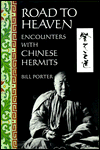 Porter, Bill. Road to Heaven: Encounters with Chinese Hermits.
Porter, Bill. Road to Heaven: Encounters with Chinese Hermits.
With photographs by Steven R. Johnson and the author. San Francisco, Mercury House, 1993.
"Throughout Chinese history, there have always been people who preferred to spend their lives in the mountains, getting by on less, sleeping under thatch, wearing old cloths, working the higher slopes, not talking much, writing even less -- maybe a few poems, a recipe or two. Out of touch with the times but not with the seasons, they cultivated roots of the spirit, trading flatland dust for mountain mist. Distant and insignificant, they were the most respected men and women in the world's oldest society."
So begins Bill Porter's fascinating travelogue of his 1989 search for hermits in contemporary China: Taoist and Buddhist, invariably, the latter Pure Land, Chan, or Tantric. What makes his exploration so enjoyable is that we have such a capable and amiable guide. Porter had long been a student of Chinese thought, a voracious reader and fine translator, and here he shows his great empathy for his favorite land and personalities.
Porter offers quick, relevant, and interesting historical and biographical anecdotes to give his readers context in every chapter and locale he visits. His see-saw progress through China coaxing reluctant officials and state-sponsored monks and abbots gives the narrative a wonderful authenticity.
Porter plunges further and wider in his search through the Chungnan Mountains, the historical refuge of ancient hermits, and we follow him up steep and dangerous cliffs, past isolated farms and villages, and into neglected temples and shrines refurbished only lately for tourists and manned by tight-lipped monks who occasionally direct Porter to the right places with a wink and a silent nod.
Most of the interviewees are real hermits, some are monks familiar with hermits and their stories. And the hermits themselves are not disappointing: reserved, philosophical, plain. We might as well be plunged 2,000 years back to ancient China, where the accoutrements of eremitic life are nearly identical.
Porter describes a farmer grinding green rind off of walnuts, the steep and slippery green rocky ascents to hermit hideaways, misadventures with suspicious police. We share a meal of corn gruel and potatoes here or a bowl of noodles and a pot of tea there. One old hermit tells Porter about his few planted vegetables, of gathering wild plants, of coming down once every couple of years. Why do you live there? asks the author. "For the quiet," comes the answer. "Zen monks like quiet."
A Taoist hermit had the single character for "sword" on his wall. Another tells him, "Buddhists and Taoists walk the same path. They just dream different dreams."
The book is enhanced by a couple of useful maps. A special treat are the many black and white photographs by the author and by photographer and traveling companion Steven R. Johnson. The wonderfully candid photos of hermits and their stark landscape are as valuable as the text. With an empathetic guide on a unique journey, this book is a solid popular introduction to Chinese hermits and, indeed, to what it means to be a hermit.
¶